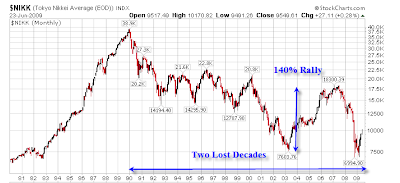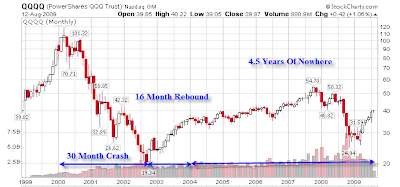Click here for a FREE, 90-day trail subscription to our PSW Report!
In this article, Mish refers to a post by John Hussman reprinted here several days ago.
Hussman on Post-Crash Dynamics
 Courtesy of Mish
Courtesy of Mish
John Hussman is nearly always a great read and his post on Post-Crash Dynamics is no exception. Here are a few snips.
If you look carefully at the economic data that shows improvement, and correct for the impact of government outlays, it is difficult to find anything but continued deterioration in private demand and investment. What we do see is a government that has run what is now a trillion dollar deficit year-to-date, representing some 7% of GDP. That sort of tab will undoubtedly buy some amount of Cool-Aid, but it has been something of a disappointment to watch how eagerly investors have guzzled it down. This is like somebody borrowing money from their Uncle and then celebrating that their income has gone up.
Moreover, it might be enticing to look at a chart of the S&P 500 and envision a quick return to 2007 highs and beyond, but it is important to recognize that those highs were based on profit margins about 50% above historical norms, combined with an elevated P/E multiple of about 19 against those earnings. Even if the economy is poised for a sustained recovery here, the belief that those joint outliers will be quickly re-established goes against historical precedent.
Post-Crash Dynamics
click on chart for sharper image
When markets crashes are coupled with changes in the fundamentals that supported the preceding bubble – as we observed in the post-1929 market, the gold market of the 1980’s, and the post-1990 Japanese market, and currently observe in the deflation of the recent debt bubble – they typically do not recover quickly. Indeed, the hallmark of these post-crash markets is the very extended sideways adjustment that they experience, generally for many years.
The above chart shows the length of time stock markets may go nowhere following a crash. The annotations in bright red are mine, and the picture is not a pretty one. I have posted a similar chart of the Nikkei many times.
Two Lost Decades
The Japanese Stock Market is about 25% of what it was close to 20 years ago! Yes, I know, the US is not Japan, that deflation can’t happen here, etc, etc. Of course deflation did happen here, so the question now is how long it lasts. Even if it does not last long, there are no guarantees the stock market stages a significant recovery.
QQQQ Monthly Chart
click on chart for sharper image
In the wake of the "Nascrash", technology stocks rebounded sharply for about 16 months, nearly doubling in price. Yet, going on 5 years later, share price is now roughly in the same spot as it was at the beginning of 2004, less than 40% of its peak price in 2000.
Fundamentally and technically, those expecting the S&P to recover to peak 2007 levels anytime soon are in for a rude awakening. Such is the nature of Post-Crash Dynamics.





